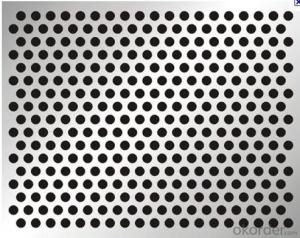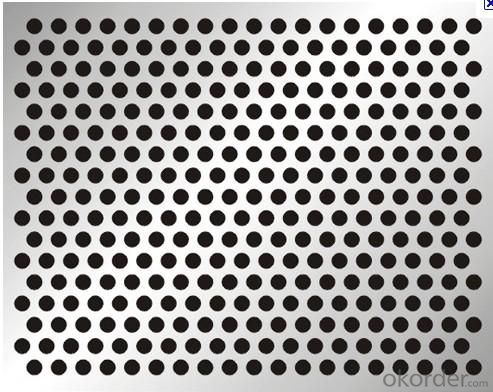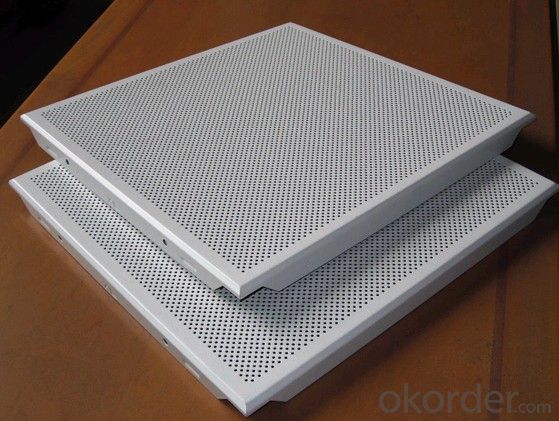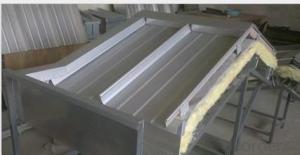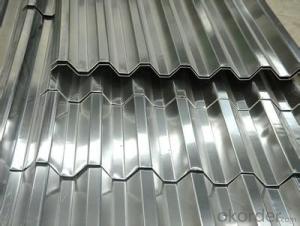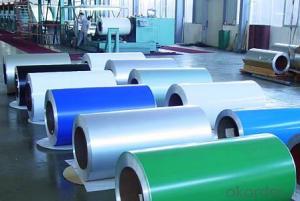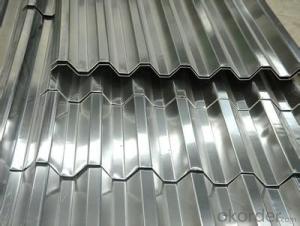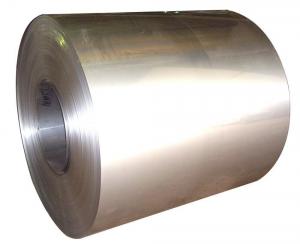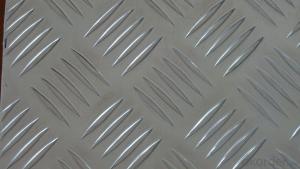Dibond Aluminum Roof Sheets
- Loading Port:
- China Main Port
- Payment Terms:
- TT OR LC
- Min Order Qty:
- -
- Supply Capability:
- -
OKorder Service Pledge
OKorder Financial Service
You Might Also Like
Aluminium alloys with a wide range of properties are used in engineering structures. Alloy systems are classified by a number system (ANSI) or by names indicating their main alloying constituents (DIN and ISO).
The strength and durability of aluminium alloys vary widely, not only as a result of the components of the specific alloy, but also as a result of heat treatments and manufacturing processes. A lack of knowledge of these aspects has from time to time led to improperly designed structures and gained aluminium a bad reputation.
One important structural limitation of aluminium alloys is their fatigue strength. Unlike steels, aluminium alloys have no well-defined fatigue limit, meaning that fatigue failure eventually occurs, under even very small cyclic loadings. This implies that engineers must assess these loads and design for a fixed life rather than an infinite life.
Another important property of aluminium alloys is their sensitivity to heat. Workshop procedures involving heating are complicated by the fact that aluminium, unlike steel, melts without first glowing red. Forming operations where a blow torch is used therefore require some expertise, since no visual signs reveal how close the material is to melting. Aluminium alloys, like all structural alloys, also are subject to internal stresses following heating operations such as welding and casting. The problem with aluminium alloys in this regard is their low melting point, which make them more susceptible to distortions from thermally induced stress relief. Controlled stress relief can be done during manufacturing by heat-treating the parts in an oven, followed by gradual cooling—in effect annealing the stresses.
The low melting point of aluminium alloys has not precluded their use in rocketry; even for use in constructing combustion chambers where gases can reach 3500 K. The Agena upper stage engine used a regeneratively cooled aluminium design for some parts of the nozzle, including the thermally critical throat region.
Another alloy of some value is aluminium bronze (Cu-Al alloy).
- Q: How are aluminum sheets tested for quality and compliance with industry standards?
- Quality and compliance with industry standards for aluminum sheets are ensured through a comprehensive range of tests and inspections. These tests guarantee that the desired specifications and performance criteria are met by the sheets. Visual inspection is one of the commonly utilized tests, where the sheets are thoroughly examined for any surface defects like scratches, dents, or cracks. This examination is crucial to ensure a flawless and smooth appearance. Furthermore, dimensional checks are carried out to verify the thickness, width, and length of the sheets. Precise measurements are essential to meet the specific requirements of the intended application. Various tests are conducted to evaluate the mechanical properties. Tensile strength tests assess the maximum load the aluminum sheet can bear before breaking. This aids in determining the structural integrity of the sheet and its ability to withstand external forces. Similarly, hardness tests measure the sheet's resistance to indentation or penetration, providing insights into its durability and resistance to wear. Chemical composition analysis is also undertaken to ensure that the aluminum sheets contain the necessary alloying elements within the specified limits. This analysis helps confirm that the material composition aligns with industry standards, as different alloy compositions can affect the mechanical properties of the sheets and their suitability for various applications. Corrosion resistance tests assess the sheet's capacity to withstand environmental factors like moisture, chemicals, and temperature variations, thereby evaluating its surface integrity. This evaluation is particularly important for applications where aluminum sheets are exposed to corrosive substances or harsh environments. In addition to these tests, non-destructive testing techniques such as ultrasonic testing or eddy current testing may be employed on aluminum sheets. These methods help identify internal defects or irregularities that may not be visible through visual inspection alone. Overall, a combination of visual inspections, dimensional checks, mechanical tests, chemical composition analysis, and surface integrity evaluations are utilized to ensure that aluminum sheets meet the quality standards and compliance requirements set by the industry. These rigorous testing procedures guarantee that the sheets are suitable for their intended purpose and fulfill the expectations of customers.
- Q: What is the typical machinability of aluminum sheets?
- The typical machinability of aluminum sheets is considered to be excellent. Aluminum is known for its softness and low density, which makes it relatively easy to machine. It can be cut, drilled, and formed with relative ease, allowing for efficient and precise machining processes. However, the specific machinability of aluminum sheets can vary depending on factors such as alloy composition, temper, and thickness.
- Q: Can aluminum sheets be used for solar reflectors?
- Yes, aluminum sheets can be used for solar reflectors. Aluminum has a high reflectivity, meaning it can effectively reflect sunlight and reduce heat absorption. This makes it an ideal material for solar reflectors, which redirect and concentrate sunlight onto solar cells or other energy-absorbing devices.
- Q: So my new farrier comes out tomorrow and charges $20 more for aluminum shoes and I was wondering why that is? Is one better than the other? My horse is a TB hunter jumper. Tell me what you think :)
- Unless you have a specific reason for aluminum, the steel is better. It is more rigid, and supplies more support to the hoof wall. The aluminum bends if the horse steps on something, stressing the hoof wall. I used them for an OTTB who had weak, shelly hooves in front. He threw shoes like second graders throw spitballs... and when a steel shoe would come off, so would half his hoof wall. I switched to aluminum; the smaller nails stressed the hoof less, and the light weight put less stress on the nails. He still threw the shoes, but his hoof wall stayed intact - a great improvement. I evented and hunter paced this horse in these shoes. They wore pretty well, and I had them reset many times. I din't use the racing plates (even lighter and thinner), but got regular shoes made from aluminum. However, unless you have a similar hoof problem, I'd stick with steel. Edit: they're more expensive because aluminum costs more, and he can't buy them in bulk because fewer people use them. They're also harder to put on properly, because the aluminum nails bend really easily. They can be harder to shape, again because they bend easily and if you're used to bending steel, you have to develop the touch for it.
- Q: Can aluminum sheets be used for heat dissipation?
- Yes, aluminum sheets can be used for heat dissipation. Aluminum is known for its excellent thermal conductivity, which allows it to efficiently transfer heat away from a source. This makes it a popular choice for heat sinks and heat exchangers in various industries. Aluminum sheets can be shaped and formed into different configurations to maximize surface area and enhance heat dissipation. The lightweight and corrosion-resistant nature of aluminum also make it a preferred material for heat dissipation applications.
- Q: What are the different methods of surface coating for aluminum sheets?
- There are various methods of surface coating available for aluminum sheets, each offering unique benefits and applications. Some of the most commonly used methods include: 1. Anodizing: This process involves creating a protective oxide layer on the surface of the aluminum by immersing it in an electrolytic solution. Anodizing provides enhanced corrosion resistance, improved durability, and can also be used to achieve decorative finishes. 2. Powder coating: Powder coating involves applying a dry powder onto the surface of the aluminum and then curing it through a heating process. This method provides a durable and attractive finish, with excellent resistance to abrasion, chemicals, and UV rays. 3. Painting: Aluminum sheets can be coated with conventional liquid paints to achieve various colors and finishes. This method allows for customization and offers good corrosion protection, but may not be as durable as other methods. 4. Cladding: Cladding involves bonding a protective layer, such as stainless steel or other metals, onto the surface of the aluminum sheet. This method provides superior protection against corrosion, impact, and extreme weather conditions. 5. Laminating: Laminating involves applying a thin layer of protective material, such as PVC or PET film, onto the surface of the aluminum sheet. This method enhances the sheet's resistance to scratching, staining, and fading, making it suitable for applications requiring long-term durability. 6. Chemical conversion coating: This method involves treating the aluminum surface with a chemical solution to create a thin, protective layer. Chromate conversion coating, for example, enhances corrosion resistance and improves paint adhesion. 7. Electrophoretic deposition (EPD): EPD involves immersing the aluminum sheet in a water-based paint solution and applying an electric current to deposit the paint particles onto the surface. This method provides uniform coating thickness and excellent corrosion resistance. Each of these surface coating methods offers specific advantages and is suited for different applications. Choosing the appropriate method depends on the desired properties, aesthetics, and the intended use of the aluminum sheets.
- Q: how to avoid oxidation of aluminum sheet after wire drawing?
- leave it alone after wire drawing!aluminum sheet will formulate a layer of dense oxide film. So you don't need to worry about it! Don't often polish the aluminum wire, or they will be more and more slimsy, the oxide film is used for avoiding reoxidation.
- Q: This question asks about the impact of aluminum sheets on the air quality inside a building.
- <p>Aluminum sheets themselves do not directly affect indoor air quality. They are inert materials that do not emit volatile organic compounds (VOCs) or other harmful substances. However, the installation process might involve adhesives or sealants that could release VOCs temporarily. Proper ventilation during and after installation can mitigate this issue. Additionally, aluminum sheets can contribute to better air quality by enhancing thermal performance, reducing energy consumption for heating and cooling, and indirectly lowering emissions from power plants.</p>
- Q: Can aluminum sheets be an alternative to wood in certain applications?
- Certainly, aluminum sheets can serve as a viable substitute for wood in specific applications. Aluminum boasts numerous advantages over wood, rendering it a favored choice across various industries. Primarily, aluminum exhibits exceptional durability and longevity due to its resistance to corrosion, rot, and pests. Consequently, it proves ideal for outdoor usage or areas with high moisture levels. Moreover, aluminum sheets are lightweight, facilitating easier handling and transportation in comparison to wood. Additionally, they possess a commendable strength-to-weight ratio, enabling them to withstand heavy loads while maintaining their structural integrity. Moreover, aluminum stands as a sustainable material, capable of indefinite recycling without compromising its properties. Conversely, wood necessitates the felling of trees, thereby carrying environmental implications. Aluminum sheets also offer a high degree of design flexibility, readily assuming complex structures through shaping, bending, and forming. This adaptability allows for innovative and creative applications. Furthermore, aluminum exhibits excellent thermal and electrical conductivity, rendering it suitable for scenarios where heat dissipation or electrical conductivity plays a crucial role. Nonetheless, it is crucial to acknowledge that wood retains its unique characteristics and benefits in certain applications. Wood imparts a warm and natural aesthetic that aluminum fails to replicate, making it a preferred choice in interior design or furniture manufacturing. Additionally, wood qualifies as a renewable resource and exhibits excellent insulation properties, proving advantageous in construction or insulation applications. Consequently, while aluminum sheets can serve as a fantastic substitute for wood in numerous instances, the ultimate choice hinges upon the specific requirements and desired outcomes of the application at hand.
- Q: Hi,I need some interesting facts about AluminiumLike who found/discovered it, and how, or/and history of it. Recycling it, or does it have effects on the environment,Thanks if you can help,Thank you thank you thank you!Xx
- Aluminium is remarkable for the metal's low density and for its ability to resist corrosion due to the phenomenon of passivation. Structural components made from aluminium and its alloys are vital to the aerospace industry and are very important in other areas of transportation and building. Its reactive nature makes it useful as a catalyst or additive in chemical mixtures, including ammonium nitrate explosives, to enhance blast power. all the ifo u need isat the link below
Send your message to us
Dibond Aluminum Roof Sheets
- Loading Port:
- China Main Port
- Payment Terms:
- TT OR LC
- Min Order Qty:
- -
- Supply Capability:
- -
OKorder Service Pledge
OKorder Financial Service
Similar products
Hot products
Hot Searches
Related keywords
